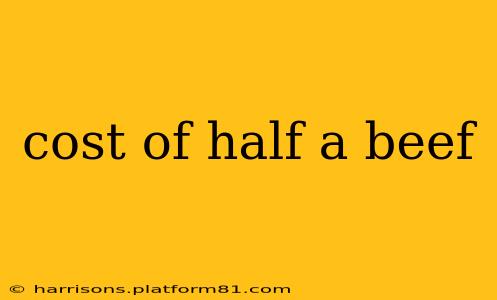Buying half a beef is a significant undertaking, offering substantial savings compared to purchasing individual cuts at the grocery store. However, the total cost varies considerably depending on several factors. This guide will break down the price, explore influencing factors, and answer common questions surrounding the cost of half a beef.
What Factors Influence the Cost of Half a Beef?
Several key factors determine the final price you'll pay for half a beef:
-
Breed of Cattle: Different breeds command different prices. Angus beef, known for its marbling and flavor, tends to be more expensive than other breeds. Grass-fed beef also often carries a higher price tag.
-
Weight of the Animal: A larger animal will naturally yield more meat, resulting in a higher overall cost. However, the price per pound might be lower.
-
Processing Fees: These fees cover the butchering, cutting, wrapping, and freezing of the meat. These costs can vary significantly depending on the butcher's location and services offered. Some butchers offer additional services like custom cuts or sausage-making, which will increase the overall cost.
-
Location: Geographic location plays a significant role in pricing. Rural areas may have lower costs than urban areas due to reduced transportation and overhead costs for the butcher.
-
Time of Year: Prices can fluctuate throughout the year, often reflecting seasonal availability and demand.
-
Type of Purchase: Are you buying directly from a farmer, a butcher, or through a co-op? Each option will have different pricing structures.
How Much Does Half a Beef Typically Cost?
Providing an exact price is challenging due to the variables listed above. However, a reasonable estimate for half a beef (hanging weight, before processing) can range from $600 to $1500 or more. This doesn't include processing fees, which can add another $300-$800 depending on the services chosen. Therefore, the total cost can easily reach $900 to $2300 or more.
How Much Meat Do You Get From Half a Beef?
The amount of meat you receive depends on the size of the animal. A typical steer might yield 400-600 pounds of hanging weight. Half of that would be 200-300 pounds. Remember that this is before processing, and some weight will be lost during butchering and trimming. You might end up with approximately 150-250 pounds of usable meat after processing.
What Cuts of Meat Will I Receive?
The cuts you receive will depend on your preferences and the butcher's capabilities. You will typically receive a variety of cuts, including:
- Steaks: Ribeye, New York strip, sirloin, T-bone, etc.
- Roasts: Chuck roast, brisket, eye of round, etc.
- Ground Beef:
- Short Ribs:
- Other Cuts: Various smaller cuts suitable for stews, soups, and other dishes.
Is Buying Half a Beef Worth It?
Buying half a beef can be a very economical choice for families who consume a lot of beef. The per-pound cost is usually significantly lower than purchasing individual cuts from the grocery store. However, it requires freezer space and some planning to ensure proper storage and use of all the meat before it spoils.
What are the advantages and disadvantages of buying half a beef?
Advantages:
- Cost Savings: Significant savings compared to buying individual cuts at the grocery store.
- High-Quality Meat: Often higher quality meat compared to supermarket options.
- Variety of Cuts: Access to a wider variety of cuts than you'd find in a typical grocery store.
Disadvantages:
- Requires Freezer Space: You'll need ample freezer space to store the large quantity of meat.
- Upfront Cost: The initial investment is substantial.
- Requires Planning: Requires careful planning to ensure all the meat is used before it spoils.
This guide provides a comprehensive overview of the costs involved in purchasing half a beef. Remember to contact local butchers and farmers for accurate pricing in your area and to discuss your specific needs.
